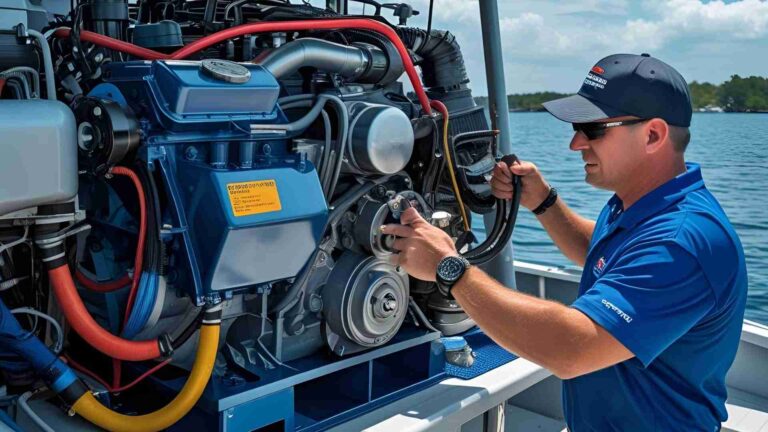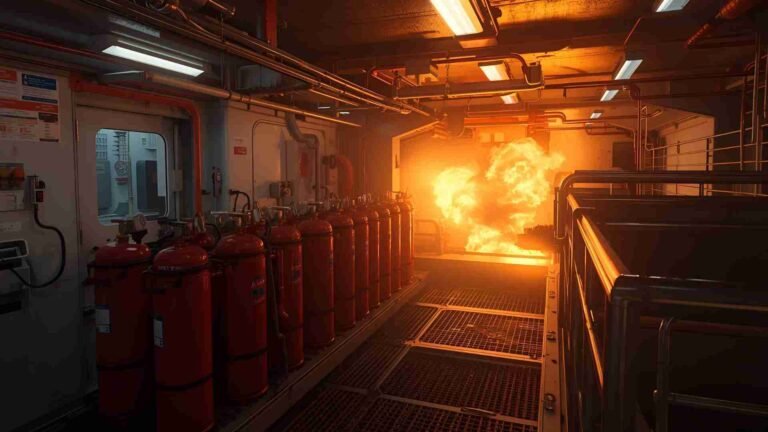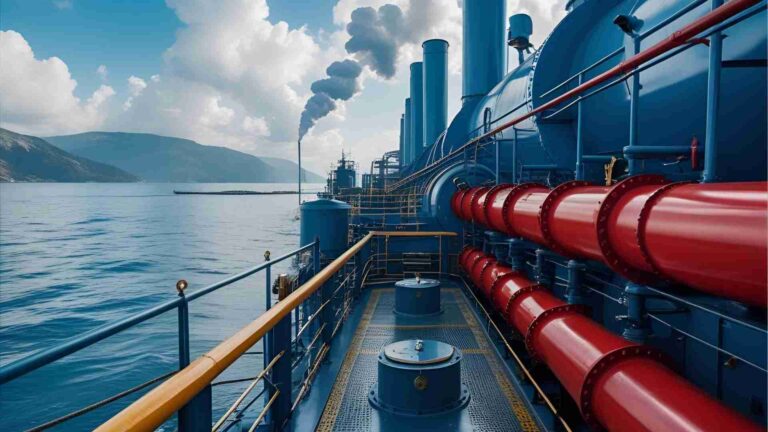Ship Marine Engineering Systems
Explore ship marine engineering systems: propulsion, power, auxiliary, and control systems for optimal vessel performance.
Marine engineering is the backbone of maritime operations, integrating mechanical, electrical, electronic, and computer engineering to design, operate, and maintain the complex systems aboard ships, submarines, and other marine vessels. These systems ensure vessels function efficiently, safely, and sustainably in the challenging marine environment. This article delves into the core components of ship marine engineering systems, their interdisciplinary nature, modern trends, challenges, and career opportunities, providing a comprehensive overview for enthusiasts, professionals, and students.
Overview of Marine Engineering Systems
Marine engineering systems encompass the critical infrastructure that powers and sustains a vessel’s operations. These systems are often described as a “system of systems,” where individual subsystems like propulsion, power generation, auxiliary systems, and control systems work in harmony to achieve greater functionality than the sum of their parts. For example, a propulsion system is useless without supporting fuel, cooling, and control systems, much like how the human body relies on interconnected organs to function.
Marine engineering also extends to ocean engineering, which includes the design of offshore structures like platforms, wind farms, and coastal defenses. The field draws heavily on disciplines such as mechanical engineering for propulsion design, electrical engineering for power distribution, and computer engineering for automation and control systems.
Key Components of Marine Engineering Systems
Marine engineering systems are categorized into several key areas, each critical to a vessel’s performance:
1. Propulsion Systems
Propulsion systems are the heart of any vessel, converting energy into motion to navigate through water. The primary components include:
- Engines: Diesel engines dominate due to their efficiency and reliability, though gas turbines and steam engines are used in specific applications (e.g., naval vessels and cruise ships). Diesel engines typically range from 500 kW to 100,000 kW, depending on vessel size.
- Gearboxes: These transmit power from the engine to the propeller, adjusting torque and speed. Modern gearboxes use advanced materials like hardened steel for durability.
- Propellers: Fixed-pitch or controllable-pitch propellers are designed for optimal hydrodynamic performance. Materials like bronze or stainless steel resist corrosion.
- Shafting: Connects the engine to the propeller, often spanning significant lengths in large vessels.
Example Specifications:
| Component | Specification Example | Price Range (USD) |
|---|---|---|
| Diesel Engine | MAN B&W 6S70ME-C (20 MW) | $5M–$10M |
| Gearbox | ZF Marine 6000 Series | $100K–$500K |
| Propeller | 5-Blade Controllable Pitch | $50K–$200K |
2. Power Generation Systems
Power generation systems supply electricity for onboard operations, from lighting to navigation equipment. Key components include:
- Generators: Typically diesel or gas-powered, ranging from 100 kW to 10 MW, depending on vessel size.
- Switchboards: Distribute electrical power across the ship, incorporating safety features like circuit breakers.
- Electrical Distribution Systems: Ensure reliable power delivery to all onboard systems, designed to withstand harsh marine conditions.
Chart: Power Distribution Flow

3. Auxiliary Systems
Auxiliary systems support essential vessel functions beyond propulsion and power. These include:
- Pumps and Piping: Handle fuel, water, and waste transfer. Centrifugal pumps are common, with flow rates from 10 to 1,000 m³/h.
- Heat Exchangers: Regulate temperatures in engines and HVAC systems, using seawater or freshwater as a cooling medium.
- HVAC Systems: Maintain crew comfort and equipment functionality, especially in extreme climates.
- Water Distillation and Sewage Treatment: Ensure potable water supply and environmentally compliant waste management.
4. Control Systems
Control systems enhance efficiency and safety through automation and monitoring:
- Machinery Control Systems: Monitor engine performance, fuel consumption, and system health in real time.
- Automation Systems: Reduce manual intervention by automating tasks like engine start-up or load balancing.
- Navigation and Steering Systems: Integrate radar, GPS, and autopilot for precise vessel control.
Chart: Control System Integration

5. Ship Structure and Stability
While naval architects primarily design a vessel’s structure, marine engineers ensure systems integration does not compromise stability. For instance, heavy machinery placement affects the center of gravity, requiring careful load balancing. Ballast tanks, filled with water, counteract weight shifts from cargo or fuel.
Interdisciplinary Nature of Marine Engineering
Marine engineering is inherently interdisciplinary, blending multiple fields:
- Mechanical Engineering: Designs propulsion systems, HVAC, and fluid systems.
- Electrical Engineering: Manages power generation and distribution.
- Electronic Engineering: Develops sensors and instrumentation for navigation and monitoring.
- Computer Engineering: Enables automation and digital twin technology.
- Naval Architecture: Ensures systems align with the vessel’s hydrodynamic performance.
This collaboration is critical during the design phase, where marine engineers work with naval architects to optimize vessel performance.
Historical Context
Marine engineering traces its roots to antiquity, with Archimedes developing early systems like the screw pump. The field matured during the Industrial Revolution, marked by Robert Fulton’s 1807 steam-powered Clermont, which used a paddle wheel for propulsion. By 1819, the Savannah completed the first transatlantic steamship voyage, and by the 1850s, the Great Eastern showcased the pinnacle of steam-powered engineering with its 700-foot length and 22,000-ton displacement. These milestones laid the foundation for modern marine engineering, transitioning from paddle wheels to screw propellers and advanced engines.
Modern Trends in Marine Engineering
Marine engineering is evolving rapidly, driven by technological advancements and environmental concerns:
1. Integrated Ship Design
Software tools like CAD and computational fluid dynamics (CFD) enable holistic design, simulating system interactions before construction. This reduces errors and optimizes performance.
2. Digital Twins
Digital twins are virtual models of a vessel, allowing engineers to test systems under various conditions. For example, a digital twin can predict engine wear or fuel efficiency, reducing maintenance costs.
3. Automation and Control Systems
Advanced automation minimizes human error and optimizes operations. For instance, dynamic positioning systems use real-time data to maintain a vessel’s position without anchoring.
4. Sustainable Technologies
Environmental regulations, like the International Maritime Organization’s (IMO) sulfur cap, are pushing the adoption of cleaner fuels (e.g., LNG) and hybrid propulsion systems. Electric and hydrogen-powered vessels are emerging, with companies like Wärtsilä developing zero-emission solutions.
Table: Sustainable Propulsion Options
| Propulsion Type | Fuel Efficiency | Emissions Reduction | Cost (USD) per Unit |
|---|---|---|---|
| LNG Engine | High | 20–30% CO2 | $8M–$15M |
| Hybrid System | Moderate | 10–20% CO2 | $5M–$10M |
| Hydrogen Fuel | High | Near Zero CO2 | $10M–$20M |
Challenges in Marine Engineering
Marine engineers face unique challenges due to the harsh marine environment:
1. Hydrodynamic Loading
Vessels endure millions of wave impacts over their lifetime, requiring robust designs to withstand hydrodynamic forces. Engineers use finite element analysis to model these loads.
2. Corrosion
Saltwater accelerates corrosion, necessitating protective measures like cathodic protection or anti-corrosive coatings. Sacrificial anodes, often zinc, are commonly used to protect hulls.
3. Anti-Fouling
Marine growth on hulls reduces fuel efficiency. Anti-fouling paints and electrolytic systems prevent biofouling, with copper anodes creating a toxic environment for organisms.
4. Pollution Control
Regulations like MARPOL enforce strict pollution controls. Bilge water must contain less than 15 ppm of oil before discharge, requiring oily water separators. Sulfur emissions are limited, phasing out heavy fuel oil in favor of low-sulfur alternatives.
5. Cavitation
Cavitation in propellers and pumps causes damage through implosions of vapor bubbles. Multi-blade propellers reduce cavitation by lowering shaft revolutions, critical for stealth in submarines.
Applications of Marine Engineering
Marine engineering extends beyond ships to various applications:
1. Arctic Engineering
Designing equipment for Arctic conditions requires materials that withstand extreme cold and minimal maintenance. For example, oceanographic buoys use titanium alloys for durability.
2. Coastal Design and Restoration
Coastal engineering balances “gray” (e.g., seawalls) and “green” (e.g., mangroves) solutions to combat erosion and sea level rise. Hybrid approaches often provide optimal results.
3. Deep-Sea Systems
- Life Support: Underwater habitats require pressure-resistant designs and advanced thermodynamics.
- Unmanned Underwater Vehicles (UUVs): Autonomous UUVs use AI for navigation in remote environments, with applications in exploration and defense.
4. Offshore Systems
- Oil Platforms: Must resist ocean currents and corrosion, with drilling components designed for high safety margins.
- Wind Farms: Offshore wind turbines offer higher yields but face similar structural challenges.
- Wave Energy: Prototypes like oscillating water columns aim to harness wave energy, though cost-effectiveness remains a hurdle.
5. Port and Harbor Design
Marine engineers design terminals and structures to handle specific cargos, ensuring durability against environmental loads.
System Categorization in Marine Engineering
To manage complexity, marine engineering uses standardized categorization systems like the Ship Work Breakdown Structure (SFI) and Expanded Ship Work Breakdown Structure (ESWBS). These break down a ship into hierarchical levels:
- Level 1: The ship as a whole.
- Level 2: Major categories (e.g., Hull, Propulsion, Systems).
- Level 3 and 4: Subsystems and components (e.g., Engines, Pumps).
Example SFI Breakdown (Level 2 and 3):
| Level 2 Category | Level 3 Systems |
|---|---|
| Hull | Shell Plating, Decks, Bulkheads |
| Machinery (Main) | Engines, Gearboxes, Propellers |
| Systems for Machinery | Fuel Systems, Cooling Systems |
| Ship Common Systems | HVAC, Sewage Treatment, Distillation |
Chart: SFI System Hierarchy

These structures aid in maintenance management, configuration control, and engineering change management, ensuring all systems are systematically addressed.
Career Opportunities in Marine Engineering
Marine engineering offers diverse career paths in industry, military, and academia:
Industry
Marine engineers work for companies like Oceaneering International or consult for oil giants like ExxonMobil on offshore projects. Roles include system design, maintenance, and project management.
Military
The U.S. Navy’s Seabees and Engineering Duty Officers apply marine engineering to naval vessels and infrastructure. The Army Corps of Engineers also engages in coastal projects.
Growth and Earnings
The field is projected to grow 12% from 2016 to 2026, driven by global shipping (80% of world trade by volume) and offshore energy demands. Average U.S. earnings are $96,140 annually, with top chief engineers earning over $150,000.
Education
A bachelor’s degree in marine engineering or related fields is required, with programs at institutions like MIT and Texas A&M. Key subjects include:
- Mathematics: Calculus, Differential Equations
- Mechanics: Fluid Dynamics, Strength of Materials
- Thermodynamics: Heat Transfer, Mass Transfer
- Control Engineering: Instrumentation, Automation
The Marine Engineering Systems (MES) Program, accredited by ABET, prepares students for roles as licensed officers in the U.S. Merchant Marine, with a capstone project designing marine power plants.
Table: MES Program Enrollment (2013–2023)
| Year | Sophomore | Junior | Senior | Total | Degrees Conferred |
|---|---|---|---|---|---|
| 2013-14 | 70 | 55 | 60 | 185 | 60 |
| 2018-19 | 39 | 33 | 33 | 105 | 33 |
| 2022-23 | 29 | 45 | 29 | 103 | 29 |
Notable Achievements
Marine engineering has produced remarkable feats, such as:
- Delta Works: A series of Dutch flood protection projects, named one of the Seven Wonders of the Modern World.
- Challenger Deep Descents: Over 20 individuals have reached the ocean’s deepest point using engineered submersibles.
- Oil Spill Recovery: Marine engineers played key roles in mitigating disasters like Exxon Valdez and Deepwater Horizon.
Conclusion
Ship marine engineering systems are the lifeblood of maritime operations, integrating propulsion, power, auxiliary, and control systems to ensure vessels operate efficiently and sustainably. The field’s interdisciplinary nature, coupled with advancements in automation, digital twins, and green technologies, positions it at the forefront of maritime innovation. Despite challenges like corrosion and pollution control, marine engineers continue to drive progress in ship design, offshore energy, and coastal protection. With growing demand and diverse career opportunities, marine engineering remains a vital and rewarding field for those passionate about the sea.
Happy Boating!
Share Ship Marine Engineering Systems with your friends and leave a comment below with your thoughts.
Read Marine Machinery – Heat Transfer and Thermofluid Systems until we meet in the next article.






